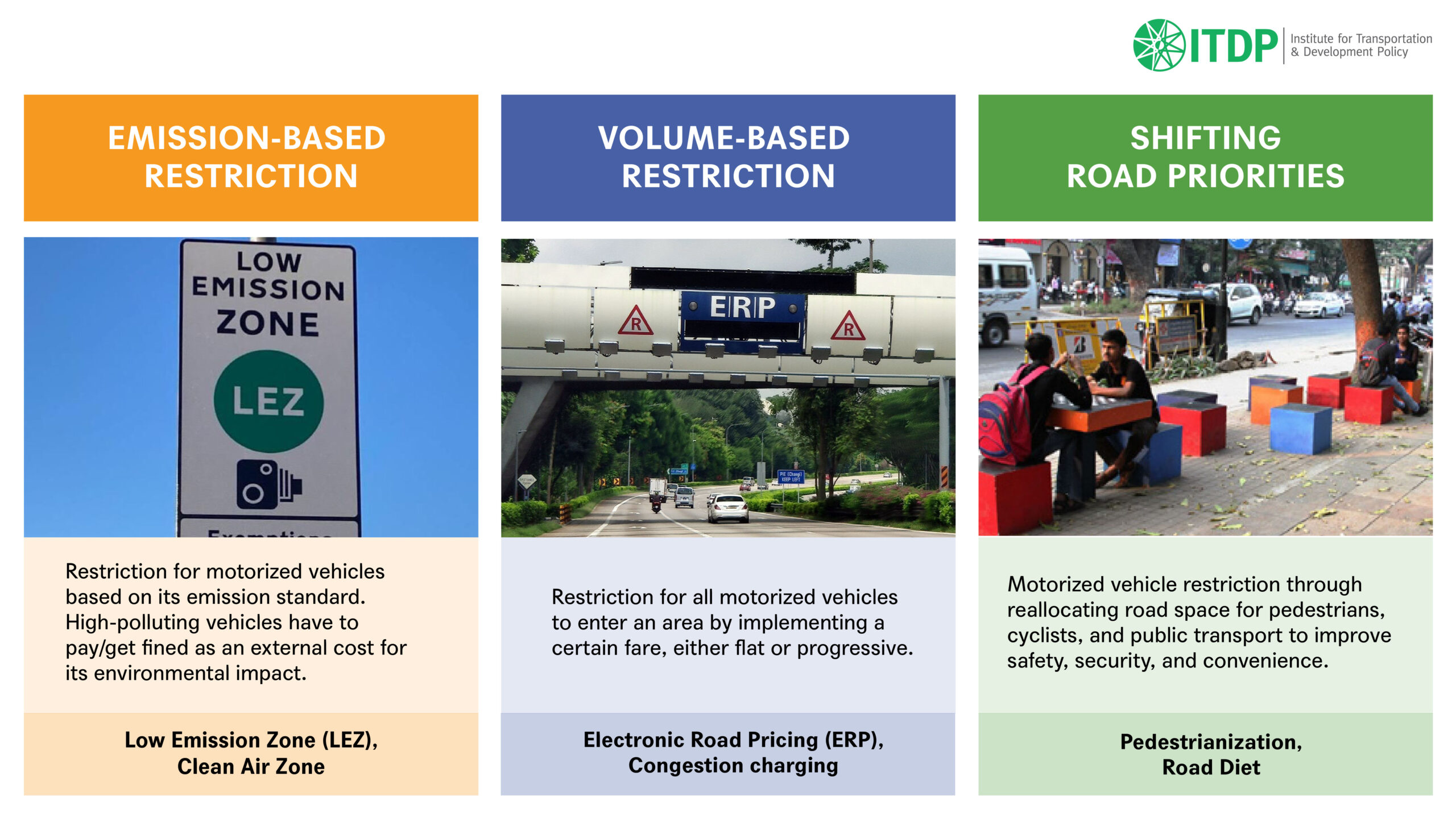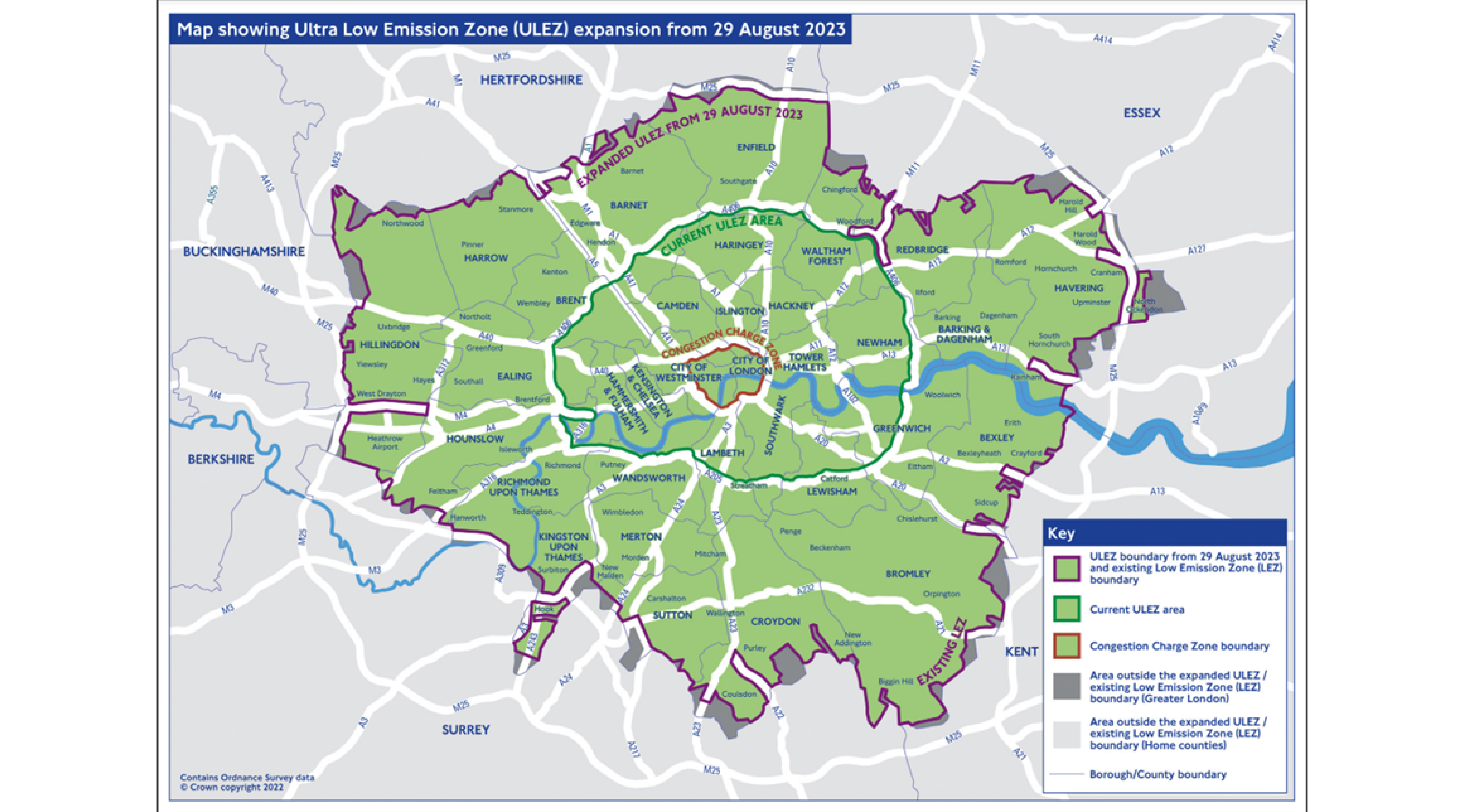May 05, 2024
Realign the Definition of LEZ in Indonesia
By Carlos Nemesis, Urban Planning II Associate ITDP Indonesia

If you ever visit Kota Tua after 2022, you will find that walking after getting off the KRL at Kota Tua Station towards Fatahillah Park is a pleasant experience. Roads that were previously used for motorized vehicle traffic have been transformed into pedestrian-only spaces, equipped with neatly arranged public spaces. The Jakarta Provincial Government then designated the Kota Tua area as a Low Emission Area (KRE) or better known as a Low Emission Zone (LEZ). However, is embedding the LEZ label in the Kota Tua area aligns with the definition and concept of LEZ development itself?
Understanding LEZ Characteristics
“LEZ” in Kota Tua is implemented in an area of 0.14 km2 with the main improvement of 5 road pedestrianization around Fatahillah Park. Even though the interventions have increased pedestrians and cyclists accessibility to public transport, unfortunately, the implementation of “LEZ” in Kota Tua has not been able to reduce area-wide air pollution below the standards set by the government [1]. The “LEZ” intervention has also not contributed significantly to reducing emissions in Jakarta due to the lack of planning and inadequate scale of the implementation area, which are relatively small [2]. To this day, high polluting vehicles can still pass and enter the area without restrictions.
More serious efforts are needed to deal with air pollution from the transportation sector, considering that the land transportation sector contributes to 58.9% of PM2.5 concentrations and 64.4% of NOx concentrations [3]. How should LEZ be planned and implemented correctly?
According to ITDP (2021) in the Taming Traffic report, LEZ is one of the ‘traffic restriction’ policy strategies or better known as ‘push policy'[4]. This policy category aims to limit the use of private motorized vehicles and encourage the use of sustainable transportation, which aims to reduce pollution in the transportation sector. There are at least three categories of traffic restrictions based on vehicle emissions, vehicle volume, and priority changes for road users.

“If the LEZ only targets polluting vehicles, ERP is aimed at all vehicles entering a certain area or corridor.”
A clear understanding of the difference between LEZ and Electronic Road Pricing (ERP) is essential because the two are often confused. If LEZ only targets polluting vehicles, ERP is aimed at all vehicles entering a certain area or corridor. A city can implement LEZ, but the vehicle volume will remain high, as is the case in the city of Milan. The Milan City Government decided to add an ERP policy in the same area to address the issue of congestion.
The final limitation is prioritizing road space for humans by pedestrianization, or by ‘road diet’ (for example, by reducing the number of motorized vehicle lanes). This strategy is usually implemented on a smaller scale than the previous two strategies because improvements are more like the physical arrangement of the road.

Let’s compare the definition of the LEZ concept again with the implementation of the Old City Low Emission Area in Jakarta. The current implementation strategy is more suitable to be categorized as a pedestrianization program. This is because the main intervention is a unique road for pedestrians, and at the same time, high-polluting vehicles can still enter the area labeled LEZ as described above. Previously, there had been restrictions with an exclusion sticker system for residents and local businesses, but this only lasted a few months.
So, can the “LEZ” in the Old City of Jakarta still be categorized as a real LEZ? No, except by implementing restrictions on access to motorized vehicles that comply with emissions. Apart from that, there is also a need to expand the LEZ implementation around the Old Town Core Area as recommended by the ITDP to increase the accessibility of the Old Town in 2022 [5].
Planning LEZ: Phasing and Scenarios

Low Emission Zone (LEZ) planning and implementation steps play a crucial role in its success. LEZs must be adapted to local characteristics and city capabilities and implemented in stages to ensure success. For example, in London, LEZ was implemented in stages, from initially targeting only logistics vehicles in 2008 to limiting all vehicles with the Ultra Low Emission Zone (ULEZ) concept in 2023. Restrictions were not immediately implemented directly in the City of London but started from the city center with an area of 21 km2 to the entire metropolitan area, which reaches 1,500 km2. As a result, vehicle compliance with emission standards increased from 39% to 91.6% by June 2023 [6], significantly reducing NOx concentrations by up to 44% in central London [7].
Various LEZ disincentive schemes can also be implemented, such as ‘paid’ and ‘unpaid’ systems. An example implementation in Antwerp, Belgium, shows vehicles above the specified standard (Euro IV) are required to have a weekly pass of €30/week (Rp. 500,000) or €50/month (Rp. 850,000). If a driver does not pay within a certain period, they will be subject to a fine of €150 (Rp. 2.5 million). On the other hand, in Seoul City, an immediate fine is imposed for vehicles that violate emission standards of 250,000 Won (Rp. 3 million).
Technical implementation of LEZ can use either automated systems or field personnel. Technology such as Automatic Number Plate Recognition (ANPR) is used to detect violations automatically, as was done in Seoul. CCTV cameras will detect the suitability of vehicle number plates with the integrated emissions database. However, if the automated infrastructure is inadequate, LEZ enforcement is done manually as in Paris, albeit with the risk of sticker counterfeiting and operational limitations.
Choosing implementation schemes and techniques that suit the city context and available resources is essential. With careful planning and gradual implementation, LEZ can be an effective instrument in reducing air pollution and improving urban air quality.
Planning The Jakarta LEZ
Jakarta, with its high pollution levels and the transportation sector being one of the main causes, requires concrete solutions to reduce air pollution. The implementation of Low Emission Zones (LEZ) as a push policy strategy can effectively reduce air pollution from the transportation sector. ITDP has developed an implementation roadmap for LEZ in Jakarta based on experiences from other cities, which has been tailored to Jakarta’s context. These recommendations are expected to meet the needs of Jakarta’s Air Pollution Control Strategy (SPPU) by 2030 and serve as a guideline for other cities in Indonesia facing similar issues.
References:
- Yulinawati, Hernani. (2022, 20 June). Presentation of: Evaluasi Kualitas Udara LEZ Kota Tua oleh Universitas Trisakti. Dissemination event from Environment Agency on the evaluation of LEZ Old Town
- C40. (2023, 7 November). Presentation of Introduction of C40’s AQUA Tools. Dissemination event from C40 and RDI on the AQUA Transport Tools
- Vital Strategies. (2020). Laporan Inventarisasi Emisi Pencemar Udara DKI Jakarta. Unpublished report.
- ITDP. (2021). Taming Traffic: Strategies to reduce driving and prioritize sustainable transportation in cities.
- ITDP. (2022). Laporan dokumentasi dan rekomendasi LEZ Kota Tua Jakarta.
- Mayor of London. 2023. Inner London Ultra Low Emission Zone – One Year Report.
- ITDP. (2023). The Opportunity of Low Emission Zones: A Taming Traffic Deep Dive Report.
Read the full document titled “Jakarta LEZ Roadmap.”


